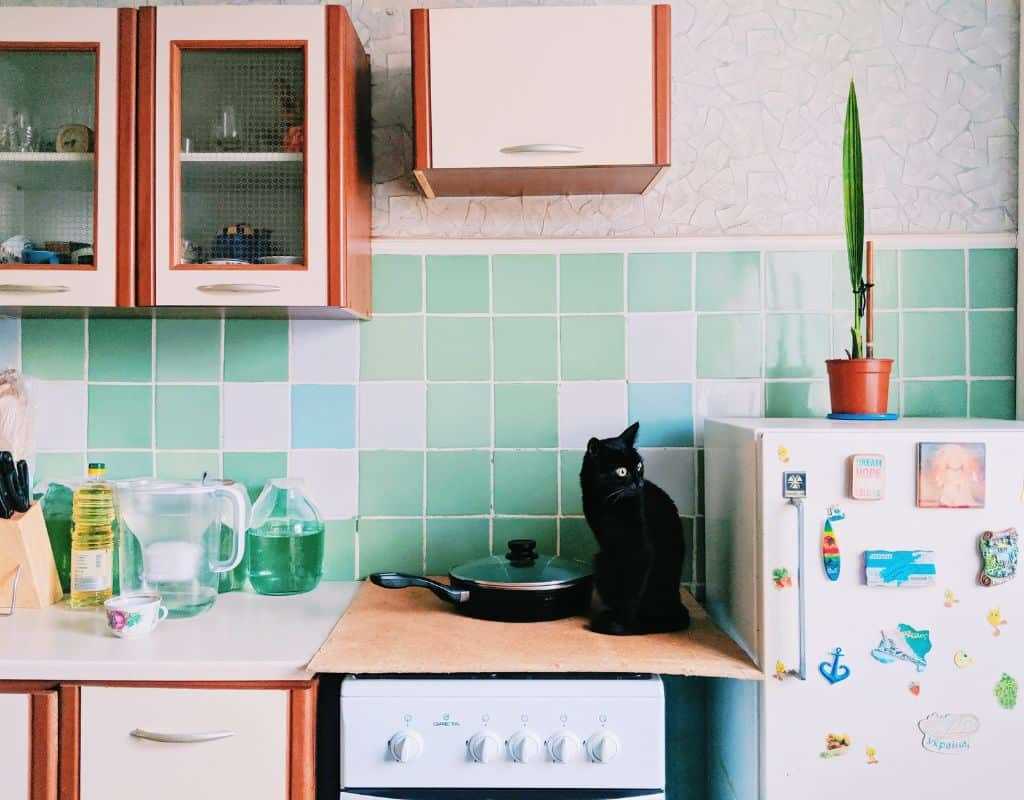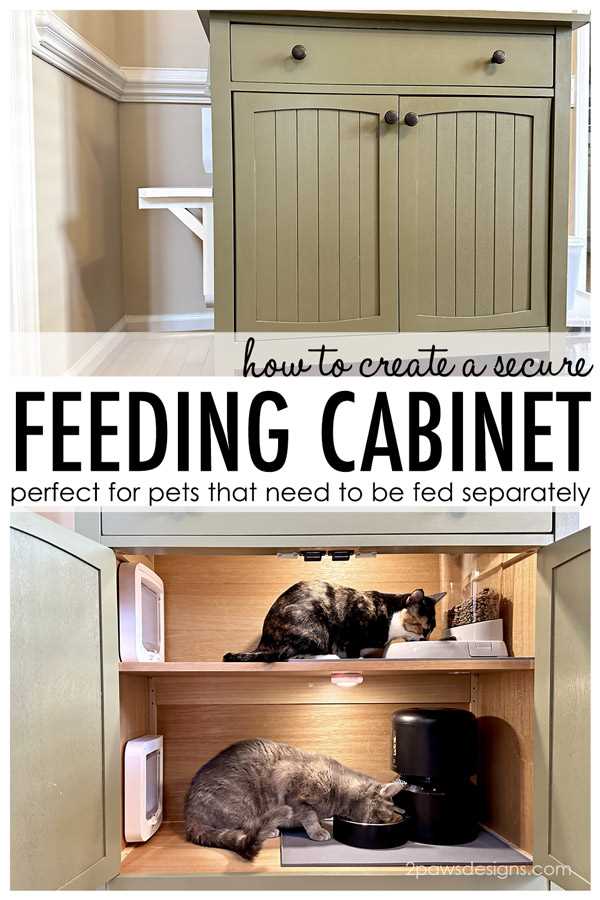First things first, consider using childproof locks on your storage spaces. These are designed to prevent little hands from getting into cabinets, and they work just as well for curious felines. Installing them can be a quick fix to keep those enticing areas off-limits.
Next, try placing double-sided tape on the surfaces of the cabinet doors. Cats dislike the sticky texture, making them think twice before jumping up. It’s a simple yet effective method that can deter those sneaky jumps.
Another tactic involves using citrus scents. Many cats are repelled by the smell of oranges and lemons. Spraying a diluted citrus solution around the cabinet edges can make the area unappealing without causing harm.
Finally, providing alternative spaces for climbing and exploration can redirect their attention. A well-placed cat tree or shelf gives them a designated area to satisfy their climbing instincts while leaving your storage areas alone.
Strategies for Deterring Felines from Cabinets
Install magnetic latches on doors. These devices require a bit of strength to open, making it less likely for me to sneak inside and explore. They’re simple to set up and can be found at most hardware stores.
Utilize Deterrent Sprays
Apply citrus-scented sprays around the edges of doorways. Most of us dislike the smell of citrus, so this can effectively discourage entry. Make sure to reapply regularly for maximum effect.
Introduce Physical Barriers

Consider using baby gates for easy access areas. These obstacles can prevent me from reaching those enticing nooks while still allowing you to access your things. I might not jump over them if they’re high enough!
Another option is to place heavy objects on top of the cabinets. If I can’t see or reach the space, my curiosity will dwindle. Use decorative boxes or plants to enhance aesthetics while blocking access.
Lastly, reward me for avoiding those areas. Positive reinforcement works wonders! Treats or extra playtime can redirect my attention elsewhere, making it easier for you to enjoy a tidy home.
Utilizing Physical Barriers to Prevent Access
Installing magnetic or child-proof locks on cabinet doors works wonders. These mechanisms are easy for humans but pose a challenge for furry friends. Ensure they are securely attached to prevent any clever paws from opening them.
Another option involves using furniture to block entry points. Place heavy objects or other furniture pieces in front of cabinets. This creates a physical barrier, making it more difficult for me and my companions to reach those enticing spaces.
Consider using mesh screens or grates as an additional protective layer. These can be fitted over cabinet openings, allowing for ventilation while keeping inquisitive noses at bay.
For those persistent creatures, a simple solution is to install sliding doors. These can be secured to prevent any unwanted exploration. They look great and keep things tidy, too!
Lastly, if you find an area particularly challenging, employing double-sided tape on the edges of cabinet doors may deter curious explorers. The sticky sensation is often unappealing and can keep paws away.
Always ensure that any barriers used are safe and non-toxic. For more information on indoor safety, check out this link: how long can an indoor cat survive outdoors.
Applying Deterrents to Discourage Exploration
Using scents that are unappealing can effectively keep me away from certain areas. Citrus smells, such as lemon or orange, are particularly effective. Spraying a diluted mixture of water and citrus essential oils around the edges of cabinets can deter my curious nature.
Sound Deterrents

Noise can be an effective barrier too. Consider placing crinkly aluminum foil or a few small bells near cabinet doors. The unexpected sound will startle me, making me think twice before jumping in.
Texture Barriers
Using double-sided tape on cabinet edges can create an unpleasant sensation when I attempt to jump up. The sticky surface is off-putting, and I quickly learn to avoid that area. Additionally, placing mats with textures I dislike, such as rubberized surfaces, can also help keep me at bay.
First things first, consider using childproof locks on your storage spaces. These are designed to prevent little hands from getting into cabinets, and they work just as well for curious felines. Installing them can be a quick fix to keep those enticing areas off-limits.
Next, try placing double-sided tape on the surfaces of the cabinet doors. Cats dislike the sticky texture, making them think twice before jumping up. It’s a simple yet effective method that can deter those sneaky jumps.
Another tactic involves using citrus scents. Many cats are repelled by the smell of oranges and lemons. Spraying a diluted citrus solution around the cabinet edges can make the area unappealing without causing harm.
Finally, providing alternative spaces for climbing and exploration can redirect their attention. A well-placed cat tree or shelf gives them a designated area to satisfy their climbing instincts while leaving your storage areas alone.
Strategies for Deterring Felines from Cabinets
Install magnetic latches on doors. These devices require a bit of strength to open, making it less likely for me to sneak inside and explore. They’re simple to set up and can be found at most hardware stores.
Utilize Deterrent Sprays
Apply citrus-scented sprays around the edges of doorways. Most of us dislike the smell of citrus, so this can effectively discourage entry. Make sure to reapply regularly for maximum effect.
Introduce Physical Barriers

Consider using baby gates for easy access areas. These obstacles can prevent me from reaching those enticing nooks while still allowing you to access your things. I might not jump over them if they’re high enough!
Another option is to place heavy objects on top of the cabinets. If I can’t see or reach the space, my curiosity will dwindle. Use decorative boxes or plants to enhance aesthetics while blocking access.
Lastly, reward me for avoiding those areas. Positive reinforcement works wonders! Treats or extra playtime can redirect my attention elsewhere, making it easier for you to enjoy a tidy home.
Utilizing Physical Barriers to Prevent Access
Installing magnetic or child-proof locks on cabinet doors works wonders. These mechanisms are easy for humans but pose a challenge for furry friends. Ensure they are securely attached to prevent any clever paws from opening them.
Another option involves using furniture to block entry points. Place heavy objects or other furniture pieces in front of cabinets. This creates a physical barrier, making it more difficult for me and my companions to reach those enticing spaces.
Consider using mesh screens or grates as an additional protective layer. These can be fitted over cabinet openings, allowing for ventilation while keeping inquisitive noses at bay.
For those persistent creatures, a simple solution is to install sliding doors. These can be secured to prevent any unwanted exploration. They look great and keep things tidy, too!
Lastly, if you find an area particularly challenging, employing double-sided tape on the edges of cabinet doors may deter curious explorers. The sticky sensation is often unappealing and can keep paws away.
Always ensure that any barriers used are safe and non-toxic. For more information on indoor safety, check out this link: how long can an indoor cat survive outdoors.
Applying Deterrents to Discourage Exploration
Using scents that are unappealing can effectively keep me away from certain areas. Citrus smells, such as lemon or orange, are particularly effective. Spraying a diluted mixture of water and citrus essential oils around the edges of cabinets can deter my curious nature.
Sound Deterrents

Noise can be an effective barrier too. Consider placing crinkly aluminum foil or a few small bells near cabinet doors. The unexpected sound will startle me, making me think twice before jumping in.
Texture Barriers
Using double-sided tape on cabinet edges can create an unpleasant sensation when I attempt to jump up. The sticky surface is off-putting, and I quickly learn to avoid that area. Additionally, placing mats with textures I dislike, such as rubberized surfaces, can also help keep me at bay.
First things first, consider using childproof locks on your storage spaces. These are designed to prevent little hands from getting into cabinets, and they work just as well for curious felines. Installing them can be a quick fix to keep those enticing areas off-limits.
Next, try placing double-sided tape on the surfaces of the cabinet doors. Cats dislike the sticky texture, making them think twice before jumping up. It’s a simple yet effective method that can deter those sneaky jumps.
Another tactic involves using citrus scents. Many cats are repelled by the smell of oranges and lemons. Spraying a diluted citrus solution around the cabinet edges can make the area unappealing without causing harm.
Finally, providing alternative spaces for climbing and exploration can redirect their attention. A well-placed cat tree or shelf gives them a designated area to satisfy their climbing instincts while leaving your storage areas alone.
Strategies for Deterring Felines from Cabinets
Install magnetic latches on doors. These devices require a bit of strength to open, making it less likely for me to sneak inside and explore. They’re simple to set up and can be found at most hardware stores.
Utilize Deterrent Sprays
Apply citrus-scented sprays around the edges of doorways. Most of us dislike the smell of citrus, so this can effectively discourage entry. Make sure to reapply regularly for maximum effect.
Introduce Physical Barriers

Consider using baby gates for easy access areas. These obstacles can prevent me from reaching those enticing nooks while still allowing you to access your things. I might not jump over them if they’re high enough!
Another option is to place heavy objects on top of the cabinets. If I can’t see or reach the space, my curiosity will dwindle. Use decorative boxes or plants to enhance aesthetics while blocking access.
Lastly, reward me for avoiding those areas. Positive reinforcement works wonders! Treats or extra playtime can redirect my attention elsewhere, making it easier for you to enjoy a tidy home.
Utilizing Physical Barriers to Prevent Access
Installing magnetic or child-proof locks on cabinet doors works wonders. These mechanisms are easy for humans but pose a challenge for furry friends. Ensure they are securely attached to prevent any clever paws from opening them.
Another option involves using furniture to block entry points. Place heavy objects or other furniture pieces in front of cabinets. This creates a physical barrier, making it more difficult for me and my companions to reach those enticing spaces.
Consider using mesh screens or grates as an additional protective layer. These can be fitted over cabinet openings, allowing for ventilation while keeping inquisitive noses at bay.
For those persistent creatures, a simple solution is to install sliding doors. These can be secured to prevent any unwanted exploration. They look great and keep things tidy, too!
Lastly, if you find an area particularly challenging, employing double-sided tape on the edges of cabinet doors may deter curious explorers. The sticky sensation is often unappealing and can keep paws away.
Always ensure that any barriers used are safe and non-toxic. For more information on indoor safety, check out this link: how long can an indoor cat survive outdoors.
Applying Deterrents to Discourage Exploration
Using scents that are unappealing can effectively keep me away from certain areas. Citrus smells, such as lemon or orange, are particularly effective. Spraying a diluted mixture of water and citrus essential oils around the edges of cabinets can deter my curious nature.
Sound Deterrents

Noise can be an effective barrier too. Consider placing crinkly aluminum foil or a few small bells near cabinet doors. The unexpected sound will startle me, making me think twice before jumping in.
Texture Barriers
Using double-sided tape on cabinet edges can create an unpleasant sensation when I attempt to jump up. The sticky surface is off-putting, and I quickly learn to avoid that area. Additionally, placing mats with textures I dislike, such as rubberized surfaces, can also help keep me at bay.







